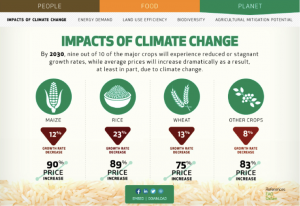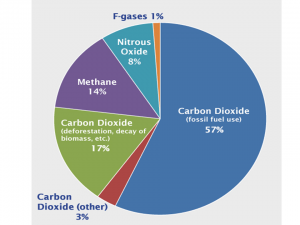Is It a Big Deal?
The effects of climate change can be catastrophic, especially to vulnerable populations. Global development institutions such as the World Bank identify climate change as a leading driver of poverty. Bold, swift, and sweeping policies must be put in place to address what 2016 Presidential candidate, Bernie Sanders, deems as the biggest threat to the United States in current history.
What Is Climate Change?
Climate change refers to the rise in surface temperatures on Earth. It is primarily a result of the burning of fossil fuels, which releases carbon dioxide and other greenhouse gases into the atmosphere. These gases trap heat, warming the Earth’s surface. Rising temperatures have adverse effects on ecosystems, weather, sea levels, etc., and these effects exacerbate poverty and the decline in  health and general well being. Vulnerable populations are most at risk.
health and general well being. Vulnerable populations are most at risk.
Scope of the Problem
Between 2030 and 2050, climate change is expected to cause approximately 250,000 additional deaths per year from malnutrition, malaria, diarrhea, and heat stress. And for many more people, climate change will impact their health and economic prosperity in other detrimental ways.
Effects on Vulnerable Populations
Children, the elderly, indigenous populations, communities of color, and the poor in rural communities, coastal regions, and urban areas are among the most vulnerable. Here are some of the challenges they encounter:
| Limited access to natural resources for rural communities | Cardiovascular and respiratory diseases | Limited access to traditional foods for indigenous populations | Food insecurity and higher food prices |
| Physical isolation, lack of economic diversity | Diarrheal and hygiene diseases | Relocation of tribal communities | Socioeconomic and health impacts |
| Suicides rates, dementia, schizophrenia | Morbidity, mortality, pediatric deaths, emergency room visits | Damage and loss to settlements | Disproportionately impacts low-income communities and communities of color |
Cap-and-Trade vs. Carbon Tax: Social or Corporate Welfare?
In order to protect our most vulnerable populations, climate change needs to be promptly addressed. Many stakeholders, including economists and policymakers, agree that attaching a price to carbon (the biggest contributor of the greenhouse gases to global warming – see Figure 1) is imperative for reducing emissions. Arguably, two of the most popular policy considerations are: (1) cap-and-trade and (2) carbon tax.
In cap-and-trade, a national cap on carbon emission is set (X units of carbon). Polluters are given permits to pollute up to their permit value, a portion of X. Any leftover amount from the permit can be negotiated and sold to other polluters via an exchange similar to the stock exchange. Polluters who want to pollute more than their permit value have to buy a bigger allowance from other permit holders. In a carbon tax, similar to a gasoline tax, polluters are taxed on the amount of carbon emitted ($Y per unit of carbon).
Figure 1
Cap-and-Trade
Advantages:
- A cap amount is established, increasing chances that emission reductions are met
- More likely to be adopted by Congress and private industry
Disadvantages:
- Essentially a regressive tax
- Fluctuating price on carbon, depending on bargains and negotiations
- Relatively favors corporations and the wealthy
Carbon Tax
Advantages:
- Provides steady revenue stream, used for clean energy initiatives or rebated to the public
- Puts a clear price on carbon, making business decision-making easier
- More transparent, no insider-driven financial instruments or backdoor negotiations
- More equitable distribution of income from taxes
- Covers the entire economy, including households and automobiles, not just certain industries
Disadvantages:
- No certainty in emission reduction – industry can pollute and just pay more taxes
- Vulnerable to loopholes, just like our current tax code
Call to Action
On an individual level, we can mitigate our environmental footprint by:
- Moving to a meat and dairy-free diet, a call from the United Nations – meat production is one of the leading causes of global warming
- Decreasing our carbon footprint – see how daily activities are contributing to carbon emissions (http://www3.epa.gov/carbon-footprint-calculator/)
- Turning your home into an energy producer – change your light bulbs and install solar panels (http://energy.gov/energysaver/planning-home-renewable-energy-systems)
On a policy level, let’s advocate for policies that put our environment (our home) and our most vulnerable populations first. Cap-and-trade, difficult to implement and enforce, has been ineffective in the European Union. The Nobel laureate economist, Joseph Stiglitz, says cap-and-trade in the U.S. is doomed for failure. A carbon tax is simpler and easier to implement, is more transparent, can be adjusted to ensure that emission targets are met, and has more equitable income distribution – thus putting public interests before private ones. Speak out, write Congress, and advocate for a tax on carbon.
